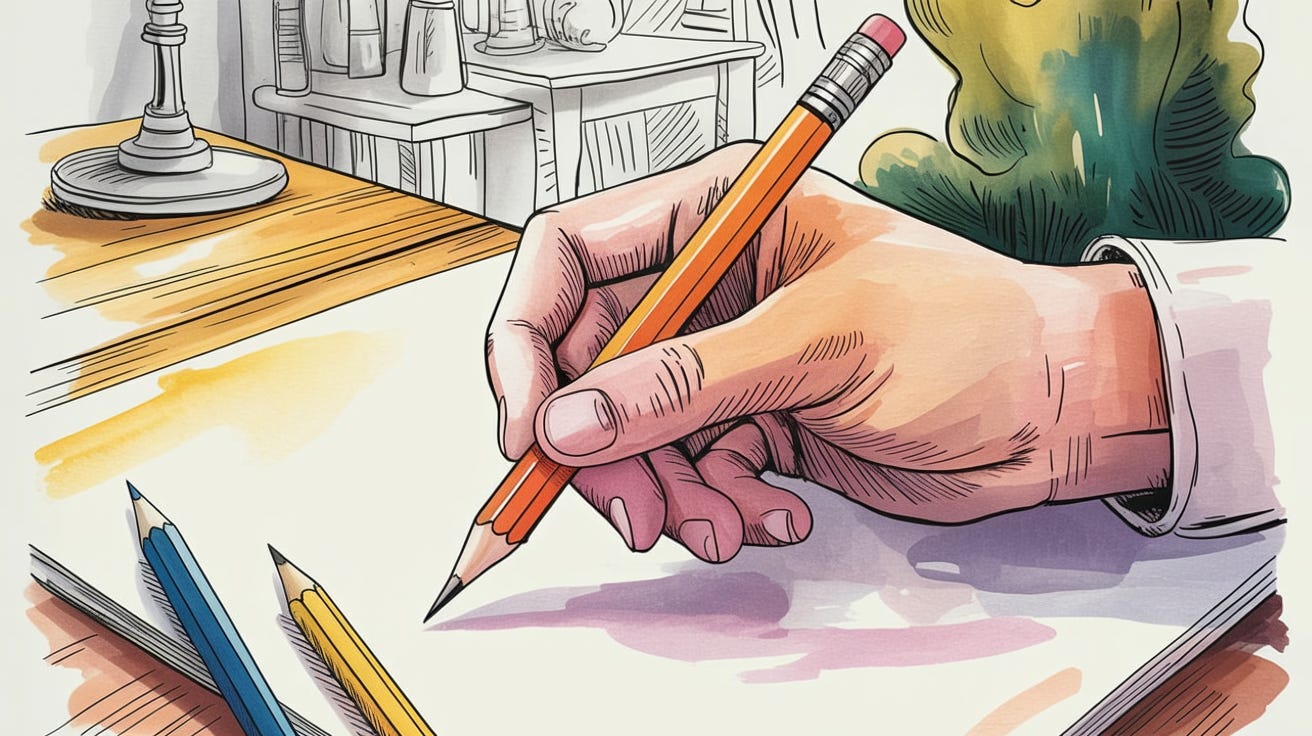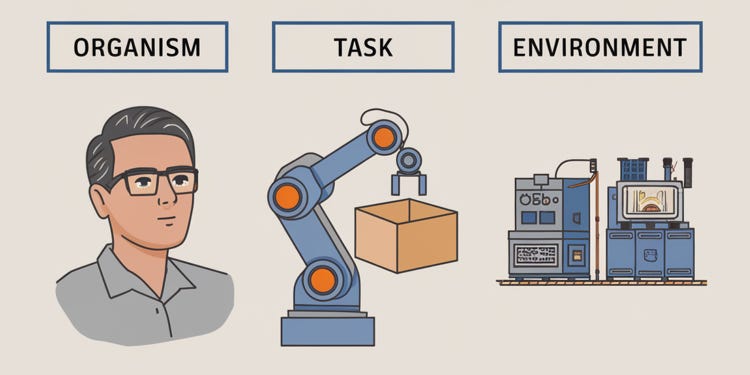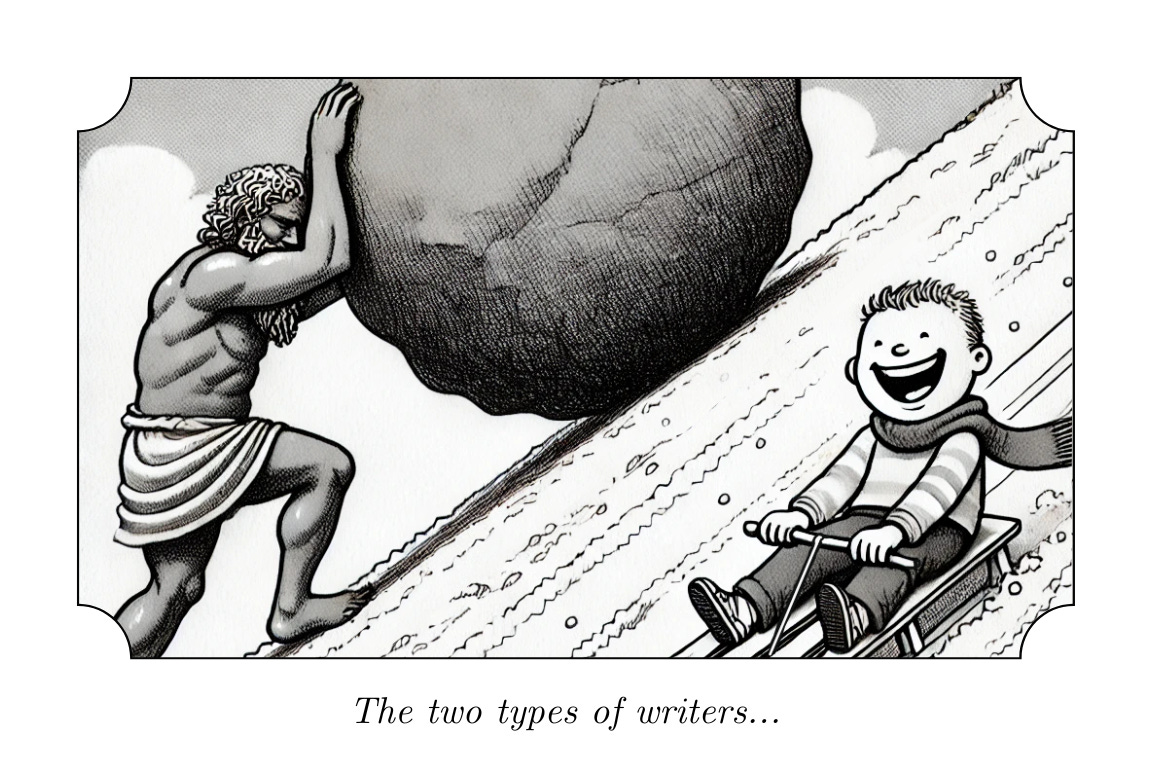⋙ Master the Fundamentals, Keep the Writing Streak Alive ⋘
Bookmark these daily “streak saver” writing exercises.
Writing can be difficult, almost like herding a squirming toddler into an itchy sweater—the child sprouts extra arms all going in different directions, and none of them willing to cooperate. You drive the story toward its exciting conclusion, but the characters have hopped into a speeding convertible heading out of town.
Maybe we've been thinking about writing all wrong. Instead of trying to imagine where you’re characters are going to end up, what if we could discover our story by understanding the natural limitations and opportunities that arise from our characters, their surroundings, and goals? Kind of like the mom who tricks her kid into a sweater by making it into a game.
I want to put a group of characters… in some sort of predicament and then watch them try to work themselves free.
— Stephen King, On Writing
Stephen King is famously distrustful of plot, and I can understand that distrust. I have outlined stories before only to realize at the end of the process I have no idea who my characters are. How does that even happen? They are wooden marionettes on strings. Instead, what if we placed characters in an environment to watch them behave?
Think about it like this: When you walk into a room, you don't have to consciously think about all the possible ways you could interact with it. You naturally perceive what's available to you based on your needs, abilities, and the environment itself. These available actions (what fancy people call "affordances") emerge from the interaction between who you are, where you are, and what you're trying to do. The same principle can apply to our characters. Instead of imposing actions on them like puppet masters, we can set up constraints—their personal limitations, their environment, and their objectives—and then watch as natural story opportunities emerge from these interactions.
Which is not to suggest you should abandon plot entirely. Just like your characters your decision to outline or not should be determined by constraints on the organism, task, and environment.
This week, we’re going to embrace the constraints in our stories—character flaws, messy settings, impossible tasks—not as limitations, but as important information that reveals fresh opportunities to act. Think of it as stepping into the story, not as a god dictating the characters’ fates, but as a curious explorer planting both feet firmly in your character’s shoes and asking, “What can you see? What can you do? And what now, genius?”
This Week’s Streak Savers 🪦
⋙ Monday, Dec 2: The Odd Hand
Setup: A character has only a few minutes to complete a practical task but they cannot use their dominant hand.
Goal: Explore how physical constraints can increase tension and delight readers with inventive solutions. Show the character engaging with their environment to find a solution.
Constraints:
Introduce an aspect of the setting that either aids or further complicates the task
Show the character’s frustration indirectly through their choices and actions
Write one page, focusing on concise, sensory details
Modification: For an added challenge, set the task in an unfamiliar or hostile environment
Reflection: Did the constraints of the setting present surprising opportunities (affordances) to help solve the problem?
⋙ Tuesday, Dec 3: Taking in the Scenery
Setup: A character encounters an object in their environment that both limits and enables their actions.
Goal: Use environmental constraints to reveal new story possibilities. Let the object's affordances guide the character’s actions.
Constraints:
Focus on one specific object in the environment
Show at least one way the object limits action
Show at least one affordance the object provides
Modification: For advanced writers, add tension by making the object’s usefulness questionable, like a barely functioning device.
Reflection: How did focusing on a single object's constraints help reveal natural story opportunities?
⋙ Wednesday, Dec 4: A Poor Fit
Setup: A character with a specific limitation (phobia, injury, skill deficit) must deal with an environment that directly challenges that limitation.
Goal: Create tension by showing how individual and environmental constraints naturally create conflict.
Constraints:
The character's limitation must be established in the first two sentences
The environment must present an immediate challenge to that limitation
The scene must maintain continuous physical action (no extended internal monologue)
End when the character succeeds or fails
Reflection: How did the interaction between personal and environmental constraints drive the action without forcing the plot?
⋙ Thursday, Dec 5: Switching Tracks
Setup: As a character is working towards an objective, a new circumstance changes that objective.
Goal: Show how changing goals reveal new opportunities within the same constraints.
Constraints:
Establish an initial clear objective
Create a reason the objective must change
End when you show how the same environment offers different affordances for the new goal
Reflection: How did changing the objective reveal previously unnoticed aspects of the environment?
⋙ Friday, Dec 6: Triple Threat
Setup: A character faces an urgent situation where personal limitations, environmental hazards, and task requirements all interact.
Goal: Write a high-stakes scene where multiple constraints create a complex web of challenges and opportunities.
Constraints:
Include one personal limitation (physical/mental/emotional)
Include one environmental hazard
Include one task with clear success/failure conditions
Show how each constraint affects the others
Modification: To reduce the challenge, add another character whose constraints balance the protagonist's shortcomings.
Reflection: How did the interaction of multiple constraints create natural plot developments?
⋙ Saturday, Dec 7: The Game-Changer
Setup: A character is caught in a difficult situation that seems to have no immediate solution.
Goal: Show how careful observation reveals hidden opportunities within existing constraints.
Constraints:
Plant a solution's elements early in the scene
Show at least two failed conventional approaches
End after a solution is found using existing elements in an unexpected way
Reflection: How did focusing on constraints help you discover creative solutions that might not have occurred otherwise?
⋙ Sunday, Dec 8: One-Page Constraints Vignette
Setup: A character faces a situation where personal, environmental, and task constraints create a seemingly impossible challenge.
Goal: Create a complete vignette where constraints naturally drive character choices and actions.
Constraints:
Include all three types of constraints (individual, environmental, task)
Show the character's perception of affordances evolving
Keep the action contained within one page
End with a choice or action that resolves the immediate situation
Modification: The resolution must come from changing how the character perceives the constraints rather than removing them.
Reflection: How did letting constraints drive the story create more organic character development and plot progression?






